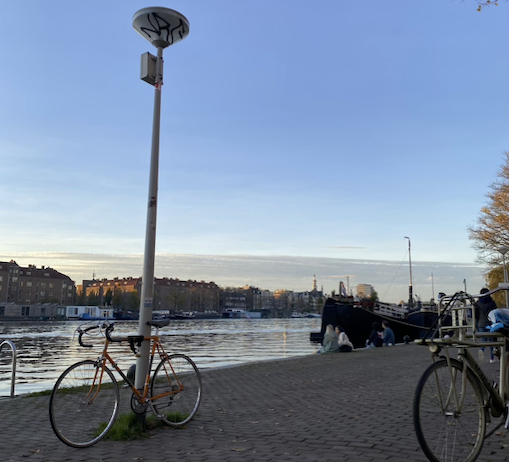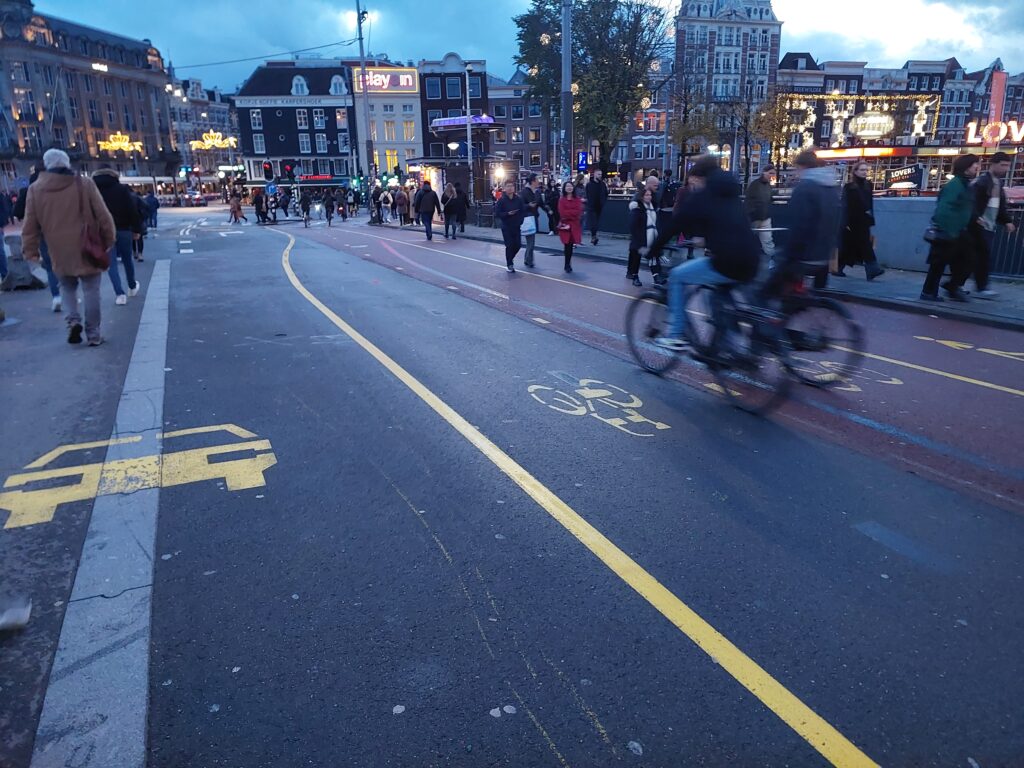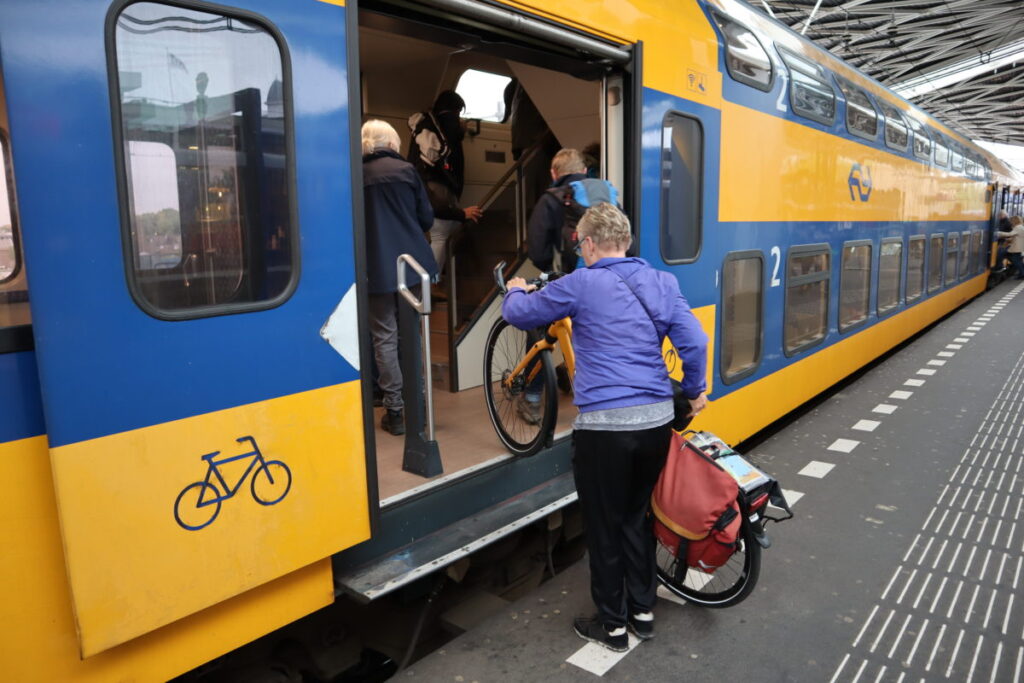Christoph Fink | LinkedIn | Twitter
Selected final essay, published 22 October 2020
Christoph works as a geographer interested in how humans shape the world. He’s also a lifetime cyclist and advocates for active urban mobility.
Unraveling the Cycling City MOOC on Coursera
This is an essay I wrote as an exercise for the massive open online course (MOOC) “Unraveling the cycling city”, organised by the Urban Cycling Institute at the University of Amsterdam. I highly recommend the course to anybody who is interested in cycling, urbanism, politics, planning, environmentalism, or social geography (or in all of those, like me, as it has truly inspiring teachers and carefully curated content.
I found my key takeaway only after looking closely at the notes I took. Their overarching theme is the political dimensions of the bicycle, cycling culture, and infrastructure. It is argued in parts of this course that, for the Dutch, the bicycle is self-evidently the best transport option in many of their everyday journeys. This, though, is only part of a much larger narrative, in which the power balance shifted in favor of cyclists due to many favourable factors coinciding:
The success had less to do with Dutch DNA or the country’s flatness than with a combination of factors, including bicycle-friendly representatives, strong bourgeois cultures, urban-planning choices, late automobility, and governmental policies.
Oldenziel & Albert de la Bruhèze 2011:42
From the urbanist perspective, contested spaces and places are the most obvious and overt manifestation of this political dimension of the bicycle. They are indeed an important factor, and for me as a social geographer, the struggle over (re-)production of space will always be a primary theme. That said, there are other, not so inherently spatial, dimensions to it. In its very early days, bicycling was an upper class pastime, but it quickly became a strong symbol of the working class, both as a vehicle for fulfilling transport needs connected to work life, and as an enabler of freedom of mobility. In my home country, Austria, the Austro-fascist regime of the 1930s introduced harsh restrictions on bicycles in an effort to weaken the social-democrat opposition. After the Nazis seized power, they waived some of these restrictions in a propaganda stunt, only to crack down on cyclists with new bureaucratic obstacles a few years later. The bicycle had become a strong political symbol.
During the interwar period, when bicycles boomed as everyday devices in the cities, the upper-middle class culturally shifted gears from cycling to promote automobile touring, while many European governments began to treat bicycle traffic as a problem to be solved rather than a solution to be embraced. At the same time, socialist, liberal, and bourgeois reformers pushed the bicycle as an instrument to uplift, discipline, and educate the working classes […].
Oldenziel & de la Bruhèze 2011:33
The Netherlands were lucky to retain a certain bourgeois interest in the bicycle, with even the royal family showing themselves on bikes in public. Giselinde Kuipers (2012:25) assesses the result of decades of reproducing cycling culture: “What is most important in habitus formation, however, is that for Dutch cyclists, all these associations and backgrounds are largely irrelevant. All Dutch are embedded in a network of conventions, habits and practices to do with cycling that are felt to be self-evident.” Kuipers’ quote makes it sound as if the societal background, the national habitus, formed themselves, but, looking closer, this political success story started out a political struggle with tremendous protests on the streets (cf. van der Zee, 2015).
This struggle continues today – even more so in other countries, where the power relations are not so obviously in favour of cycling. The predominant narrative in North America, as well as many European countries, is that of cycling as a leisure activity (Bordelon & Ferreira, 2019) which naturally should not receive as much attention as the car, the motor of a busy people’s economy. Cycling for utility is often perceived as “invisible” (Lee, 2016). Infrastructure for cyclists is often ignored and repurposed, for instance for car parking, such as in this photo I took in Kuala Lumpur, that, unfortunately, shows an all too common situation.

Ironically, the narrative further includes a notion of the cyclist as more prone to illegal activities. This is simply not true, with most of the few occasions of rule-breaking attributable to insufficient infrastructure (cf. Marshall et al. 2016). In contrast, motorists’ minor misdemeanors or petty offences often manifest a severe risk to others, simply because cars are massive, and the visibility from inside a car is lower than that of cyclists.

Cars are by far the number one cause of deaths and serious injury in accidents, but people and media don’t reflect all too much on it (Te Brömmelstroet, 2020, Culver 2018) To overcome this, scholars recommend a cycling perspective in urban design and traffic planning (Forsyth & Krizek, 2011; Bertolini & le Clerq, 2002) and a turn away from copying automotive design patterns (Liu et al. 2019; te Brömmelstroet et al. 2018). These efforts, unfortunately, often have the air of preaching to the choir; they don’t seem to reach behind the windshields of decision-makers who often are within easy reach of other lobbies (Haas & Sander, 2019). For instance, the call for more pop-up cycle lanes during the 2020 pandemic resonated loudest within the echo chambers of those who already are in support of active mobility, and, in many places, it could not spark sustainable political change. This is best illustrated by the example of Kottbusser Damm in Berlin, where a court ordered such a bike lane to be removed after pro-car lobbying.
I want to argue for a change in the strategy and priorities of bicycle advocacy. The Dutch example is quite clear: a favourable political situation emerged first, followed by a push for improved infrastructure. This, in turn, helped further shape political and societal conditions. In Finland, where I currently live, cars seem to be number one priority for traffic planning, and motorists think of themselves as the (only) rightful owners of the road. Shouldn’t we put much more effort into trying to change this mindset and establish a societal consensus on the meaningfulness of sustainable urban transport? Advocating for cycling infrastructure in an auto society tends to be a series of small steps. Its results can be mere afterthoughts to car-centric roads. The successful examples of sustainable urban transport are in places that managed to change the fundamental narrative. In the Netherlands and in Copenhagen, cyclists are not only sportists, hippies and radical rule-breakers.
It’s great to see our streets change to better accommodate people riding a bicycle or walking on foot. To make this change sustainable, let’s together make sure our streets’ culture changes, too!

References:
- Bertolini, L., le Clercq, F., 2003. Urban Development without more Mobility by Car? Lessons from Amsterdam, a Multimodal Urban Region. Environ Plan A 35, 575–589. https://doi.org/10.1068/a3592
- Bordelon, L.A., Ferreira, S.L.A., 2019. Mountain biking is for (white, wealthy, middle-aged) men: the Cape Epic mountain bike race. Journal of Sport & Tourism 23, 41–59. https://doi.org/10.1080/14775085.2019.1654906
- Culver, G., 2018. Death and the Car: On (Auto)Mobility, Violence, and Injustice. ACME: An International Journal for Critical Geographies 17.
- Forsyth, A., Krizek, K., 2011. Urban Design: Is there a Distinctive View from the Bicycle? Journal of Urban Design 16, 531–549. https://doi.org/10.1080/13574809.2011.586239
- Haas, T., Sander, H., 2019. The European car lobby. A Critical Analysis of the Impact of the Automotive Industry. Rosa-Luxemburg-Stiftung, Brussels.
- Lee, D.J., 2016. Embodied bicycle commuters in a car world. Social & Cultural Geography 17, 401–422. https://doi.org/10.1080/14649365.2015.1077265
- Liu, G., te Brömmelstroet, M., Krishnamurthy, S., van Wesemael, P., 2019. Practitioners’ perspective on user experience and design of cycle highways. Transportation Research Interdisciplinary Perspectives 1, 100010. https://doi.org/10.1016/j.trip.2019.100010
- Marshall, W.E., Piatkowski, D., Johnson, A., 2017. Scofflaw bicycling: Illegal but rational. JTLU 10. https://doi.org/10.5198/jtlu.2017.871
- Oldenziel, R., Albert de la Bruhèze, A., 2011. Contested Spaces: Bicycle Lanes in Urban Europe, 1900-1955. Transfers 1, 29–49. https://doi.org/10.3167/trans.2011.010203
- te Brömmelstroet, M., 2020. Framing systemic traffic violence: Media coverage of Dutch traffic crashes. Transportation Research Interdisciplinary Perspectives 5, 100109. https://doi.org/10.1016/j.trip.2020.100109
- te Brömmelstroet, M., Nello-Deakin, S., Quillien, J., Bhattacharya, I., 2018. Towards a pattern language for cycling environments: merging variables and narratives. Applied Mobilities 1–19. https://doi.org/10.1080/23800127.2018.1505261
- van der Zee, R., 2015. How Amsterdam Became the Bicycle Capital of the World. The Guardian. https://www.theguardian.com/cities/2015/may/05/amsterdam-bicycle-capital-world-transport-cycling-kindermoord
All photos by the author.



